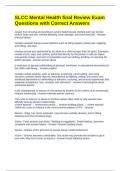SLCC Mental Health final Review Exam
Questions with Correct Answers
ranges from shoving and pushing to severe battering and choking and may involve
broken limbs and ribs, internal bleeding, brain damage, and even homicide - Answer-
physical abuse
includes assaults during sexual relations such as biting nipples, pulling hair, slapping
and hitting, and rape
involves sexual acts performed by an adult on a child younger than 18 years. Examples
include incest, rape, and sodomy performed directly by the person or with an object,
oral-genital contact, and acts of molestation such as rubbing, fondling, or exposing the
adult's genitals - Answer-sexual abuse
is malicious or ignorant withholding of physical, emotional, or educational necessities for
the child's well-being. - Answer-neglect
includes verbal assaults, such as blaming, screaming, name-calling, and using
sarcasm; constant family discord characterized by fighting, yelling, and chaos; and
emotional deprivation or withholding of affection, nurturing, and normal experiences that
engender acceptance, love, security, and self-worth. - Answer-Psychological abuse
(emotional abuse)
is the mistreatment or misuse of one person by another in the context of an emotionally
intimate relationship - Answer-Intimate partner violence
The cycle of violence or abuse is another reason often cited for why women have
difficulty leaving abusive relationships
Violent episode → honeymoon period → tension-building phase → violent episode
-While the cycle of violence is the most common pattern of IPV, - Answer-
Abuser - Edgy, has minor explosion, may become verbally abusive, minor hitting,
slapping and other incidents begin
Victim - Feels tension and afraid, "Walking on eggshells", Feels helpless, becomes
compliant and accepts blame - Answer-Tension building phase
Abuser - Batters victim (physical or sexual abuse, hostile behaviors)
Victim - Tension becomes unbearable. The victim may provoke the incident to get it
over with. May try to cover up injuries - Answer-Acute battering phase
,Abuser - Loving behavior, gives gifts and doing something special for the victim.
Contrite, sorry, makes promises to change
Victim - Trusting, hoping for change, wants to believe change will occur -
Answer-"Honeymoon phase"
occurs after a traumatic event and is characterized by re-experiencing, avoidance, and
hyper/arousal that occur from 3 days to 4 weeks following a trauma
-It can be a precursor to PTSD - Answer-Acute stress disorder
the EXTERNAL or personal benefits received from others because one is sick.
oThe person receives attention from family members, significant others, co-workers,
etc. because of the "illness/disability." (The ill person may or may not be aware of this
behavior).
oThe ill person learns that he or she "needs to be sick" to have his or her needs met.
examples:
Receiving affection from a spouse; gaining access to narcotics; avoid working; show of
concern by others; receiving comfort measures (e.g., being brought tea, receiving a
back rub).
A person with agoraphobia may receive attention and caring concern from family
members who also assume all the responsibilities of family life outside the home (e.g.,
work and shopping).
A woman demonstrates severe distress from a migraine headache as she describes her
symptoms to the nurse, but when her husband leaves the room, the woman is no longer
in pain - Answer-secondary gain
OCD Cycle:obsessions --> anxiety --> compulsions --> relief
OCD is diagnosed only when these thoughts, images, and impulses consume the
person or he or she is compelled to act out the behaviors to a point at which they
interfere with personal, social, and occupational functions.
Examples include a man who can no longer work because he spends most of his day
aligning and realigning all items in his apartment or a woman who feels compelled to
wash her hands after touching any object or person.
OCD can be manifested through many behaviors, all of which are repetitive,
meaningless, and difficult to conquer
... - Answer-OCD
obsessive compulsive disorder
, OCD is diagnosed once - Answer-thoughts or behaviors consume the person to the
point where the thoughts or actions interfere with personal, social, and/or occupational
functioning.
involves recurrent, persistent, intrusive, and unwanted thoughts, images, or impulses
(obsessions) and ritualistic or repetitive behaviors or mental acts (compulsions) carried
out to eliminate the obsessions or to neutralize anxiety. - Answer-OCD
Alcohol withdrawal, S/S include: ?
-Onset within 4 to 12 hours after cessation or marked reduction of alcohol intake;
usually peaks on the second day and complete in about 5 days
-Severe or untreated withdrawal may progress to transient hallucinations, seizures, or
delirium (DTs).-Withdrawal can be life-threatening.-Benzodiazepines for safe withdrawal
- Answer--coarse hand tremors,
-sweating,
-elevated pulse and blood pressure,
-insomnia,
-anxiety
-Detoxification (for alcohol) via drug tapering (cannot suddenly discontinue
benzodiazepines. Must taper off.)
-diazepam/Valium, lorazepam/Ativan, chlordiazepoxide/Librium. Reversal Agent is : ? -
Answer-Flumazenil
Alcohol withdrawal, nursing interventions
-IMPORTANT for the nurse to ask patient when they had their last ingestion/injection of
drug in order to know when to expect withdrawal signs.
-Do not be shy asking a patient this question. Clients will commonly let the nurse know
even if they are not asked simply because they want to be medicated before w/d s/s
begin! - Answer-
CIWAAlcohol withdrawal tool:
CIWA= Clinical Institute Withdrawal Assessment
-NAUSEA AND VOMITING—Ask, "Do you feel sick to your stomach? Have you
vomited?"
-TREMOR—Arms extended and fingers spread apart.
-PAROXYSMAL SWEATS
-ANXIETY—Ask, "Do you feel nervous?"
-AGITATION





